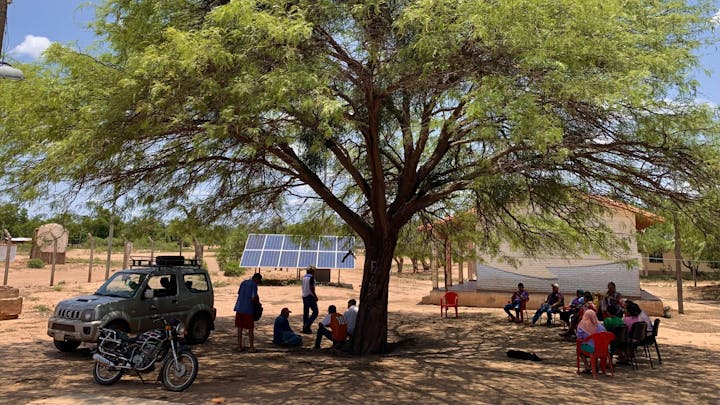Sustainable activities: tips, tricks and fine examples

At Wilde Ganzen, we support sustainable projects supported by local communities. But what do we actually mean by sustainable – and why do think it is so important? Moreover: how can we, together with the communities and the Dutch private initiative, promote the sustainable character (or approach?) of our work? This blog takes you through those questions. Based on several best practices from local partners, we identified a number of key components that benefit the long-term impact of a plan.
Sustainability: what and why
We interpret sustainable activities as interventions that bring about long-term, positive change. This is why we always aim our funds at civil society organisations’ projects for sustainable access to relevant basic services, such as healthcare facilities, clean water, adequate sanitation and education. Moreover, we support the CSOs themselves to operate autonomously and resiliently, because developments are more enduring when they are backed on the ground by powerful, independent organisations that can handle setbacks and are (partly) independent of foreign aid. Access to basic services is a huge ambition which goes beyond one single project. Therefore, we believe a sustainable activity is embedded in the community, contributing to a long-term vision or dream of the community themselves.
Levels of sustainability
When zooming in, the sustainable character of an intervention is visible at different levels. First of all, it is important to keep an eye out for the sustainability of the idea itself: can it continue (financially) after the plan is implemented? For example, because the government agrees to pay for the teacher’s salaries or because the organisation’s organised financial reserves to take care of maintenance. Second, sustainability applies to the outcome of the work. To continue with the education example: through a project that trains teachers, the quality of education improves. Lastly, we can differentiate the sustainable impact an idea has: the project addresses root causes that made the plan necessary in the first place.
Tips and tricks from partner organisations
So much for Wilde Ganzen’s vision on sustainability: let’s move to components that actually ensure the sustainable character of an activity. And who better to learn from than partner organisations like yourselves which already have achieved successful long-term, positive impact with their project? We analysed your stories to come to the following tips and tricks.
In order to gain support for a plan, it is crucial that the people that are affected by an intervention endorse the problem that it addresses, as well as assess possible solutions. When everyone is convinced that something can and should be done about it, people will be happy to contribute something. Interesting point to consider: if people don’t want to contribute, reconsider whether this idea really matches the wants and needs of the community it was set out to serve group!
If the direct beneficiaries and other stakeholders of the intervention are involved and committed and therefore own the project, they will ensure its continuity, which leads to its sustainability. Ownership closely links with community participation and resilient communities about which we wrote its own blog [insert hyperlink to blog Eline].
Education might be the most important key to sustainable change. Therefore, Wilde Ganzen started focussing more and more on supporting projects that focus on or include training people. With extra skills, people have more opportunities in their future and they can keep an undertaking running. That is why it is useful to not only teach a trade, but also relevant other skills, such as business, IT, writing or marketing skills.
The government can play a role in the continuation of an intervention after the project has been completed. As explained above, by taking over the payment of salaries, but also by recognising certificates from a training course so people can officially start working in that profession. Moreover, governments may award subsidies if public services reach a certain level. Therefore, always make sure if an activity has to live up to some standards to be able to apply for government support – and involve the government in your plans!
Another tip is to investigate what the policy plans of the local government are and how your project fits into it. In the end, the government has responsibility to ensure that citizens have access to basic needs. Therefore, communities could hold governments accountable for realisation of their basic needs. See for instance here more information about ‘the right based approach’.
As said above, (partial) independence of foreign aid benefits the sustainable character of a development. Local fundraising is not limited to the boundaries of a village or region: use the network of the community and reach former community members, classmates or relatives that moved away. Moreover, think broad: one of the organisations we work with shared as best practices an organised auction on which cattle and possessions were sold to raise money. Learn how to diversify your income in the free online course on local fundraising!
Besides local fundraising, financial independency is reached in many projects by including food production. Healthy harvest from gardens or the yield of livestock farming helps to become financially more independent. Another investment that decreases expenses are solar panels that both help you to cut electricity costs as well as improve your power supply. See for support in financial independency the Change the Game Academy Toolkits (changethegameacademy.org)
Make sure to analyse the context in which the intervention will take place and adjust the plan accordingly. Do students at your vocational school maybe need a permit to start working? Are new craftsmen actually necessary or will it create negative competition? What requirements are needed for safeguarding policies including child protection? Etc.
No magic formula
Curious about some examples of activities that caused a long-term, positive change for the community? The blogs in this newsletter are identified as best practices in terms of sustainability and served as input for this analysis. Get inspired and implement their tips and tricks to make a best practice of your own project!
